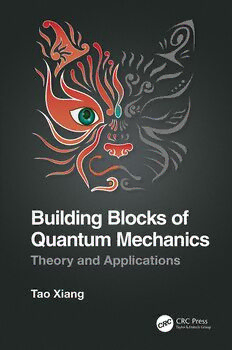Table Of ContentBuilding Blocks of
Quantum Mechanics
Building Blocks of
Quantum Mechanics
Theory and Applications
Tao Xiang
First edition published 2022
by CRC Press
6000 Broken Sound Parkway NW, Suite 300, Boca Raton, FL 33487-2742
and by CRC Press
4 Park Square, Milton Park, Abingdon, Oxon, OX14 4RN
CRC Press is an imprint of Taylor & Francis Group, LLC
© 2022 Tao Xiang
Reasonable efforts have been made to publish reliable data and information, but the author and pub-
lisher cannot assume responsibility for the validity of all materials or the consequences of their use.
The authors and publishers have attempted to trace the copyright holders of all material reproduced
in this publication and apologize to copyright holders if permission to publish in this form has not
been obtained. If any copyright material has not been acknowledged please write and let us know so
we may rectify in any future reprint.
Except as permitted under U.S. Copyright Law, no part of this book may be reprinted, reproduced,
transmitted, or utilized in any form by any electronic, mechanical, or other means, now known or
hereafter invented, including photocopying, microfilming, and recording, or in any information
storage or retrieval system, without written permission from the publishers.
For permission to photocopy or use material electronically from this work, access www.copyright.
com or contact the Copyright Clearance Center, Inc. (CCC), 222 Rosewood Drive, Danvers, MA
01923, 978-750-8400. For works that are not available on CCC please contact mpkbookspermis-
sions@tandf.co.uk
Trademark notice: Product or corporate names may be trademarks or registered trademarks and are
used only for identification and explanation without intent to infringe.
ISBN: 978-1-032-00610-9 (hbk)
ISBN: 978-0-367-77150-8 (pbk)
ISBN: 978-1-003-17488-2 (ebk)
DOI: 10.1201/9781003174882
Typeset in Nimbus Roman
by KnowledgeWorks Global Ltd.
Publisher’s note: This book has been prepared from camera-ready copy provided by the authors.
Dedication
Tomymother.
Contents
Preface.....................................................................................................................xiii
Notations..................................................................................................................xv
FormulasinSIunitsandGaussianunits................................................................xvii
Tableoffundamentalconstants..............................................................................xix
Chapter1 Introduction.....................................................................................1
1.1 Briefhistoryofquantummechanics.......................................1
1.2 Schro¨dingerequation..............................................................4
1.3 Probabilityinterpretationofwavefunction............................6
1.4 StationarySchro¨dingerequation.............................................8
1.5 Conservationofprobability....................................................8
1.6 Quantumsuperposition.........................................................10
1.6.1 Nocloningtheorem..................................................11
1.6.2 Schro¨dingercat........................................................12
1.7 Operators...............................................................................12
1.8 Quantummeasurement.........................................................13
1.8.1 Stern-Gerlachexperiment........................................14
1.9 Expectationvalues................................................................16
1.10 Problems...............................................................................17
Chapter2 One-dimensionalEigen-problem...................................................19
2.1 Symmetricpotentialandparity.............................................19
2.2 Freeparticle..........................................................................20
2.3 Delta-functionnormalization................................................23
2.4 Infinitesquarewellpotential ...............................................24
2.5 Finitesquarewellpotential..................................................27
2.5.1 Boundstates−V <E≤0........................................27
2.5.2 ScatteringstatesE>0.............................................31
2.6 Quantumtunneling...............................................................33
2.7 Delta-functionpotential........................................................35
2.7.1 Boundstate(α<0andE<0)...............................36
2.7.2 Scatteringstate(E>0)............................................37
2.8 TheWKBapproximation.....................................................38
2.8.1 Solutionaroundaturningpoint...............................40
vii
viii Contents
2.8.2 Theconnectionformulae.........................................41
2.8.3 Quantizationofenergylevels...................................43
2.9 Problems...............................................................................45
Chapter3 Representationtheoryofquantumstates.......................................47
3.1 Representation......................................................................47
3.1.1 Diracbracketnotations............................................47
3.1.2 Representationofquantumstates............................48
3.1.3 Hermitianoperators.................................................49
3.1.4 EigenstatesofHermitianoperators..........................50
3.1.5 Representationofoperators.....................................53
3.1.6 RepresentationofSchro¨dingerequation..................53
3.1.7 Feynman-Hellmanntheorem...................................53
3.2 Basistransformation.............................................................54
3.2.1 Example:Fromrealtomomentumspacerepre-
sentation...................................................................55
3.3 Commutators.........................................................................56
3.3.1 Propertiesofcommutableoperators........................56
3.3.2 Propertiesofnoncommutableoperators..................57
3.4 Schro¨dingerpicture...............................................................59
3.4.1 Virialtheorem..........................................................60
3.4.2 Ehrenfesttheorem....................................................60
3.5 Heisenbergpicture................................................................61
3.6 Uncertaintyprinciple............................................................62
3.7 Thetime-energyuncertaintyprinciple..................................64
3.8 Problems...............................................................................66
Chapter4 HarmonicOscillators.....................................................................69
4.1 One-dimensionalharmonicoscillator...................................69
4.1.1 Ladderoperators......................................................69
4.1.2 Eigen-spectrum........................................................70
4.1.3 Eigenfunction...........................................................71
4.1.4 Occupationrepresentation.......................................72
4.2 Coherentstate.......................................................................73
4.2.1 Minimumuncertaintystate......................................73
4.2.2 Wavefunctionofthecoherentstate.........................74
4.3 Chargedparticlesinanelectromagneticfield.......................75
4.3.1 Minimalcoupling.....................................................75
4.3.2 Gaugeinvariance......................................................76
4.3.3 Probabilitycurrent...................................................76
4.3.4 Aharonov-Bohmeffect............................................77
4.4 Landaulevels........................................................................79
4.4.1 Landaugauge...........................................................79
4.4.2 DegeneracyofLandaulevels...................................80
Contents ix
4.4.3 Symmetricgauge.....................................................81
4.4.4 LowestLandaulevel................................................82
4.5 Problems...............................................................................85
Chapter5 AngularMomentum......................................................................87
5.1 Orbitalangularmomentum...................................................87
5.2 Generalangularmomentum.................................................88
5.2.1 Matrix representation of angular momentum
operators...................................................................90
5.3 Eigenfunctionsoforbitalangularmomentum......................91
5.4 Spinangularmomentum.......................................................95
5.4.1 Paulimatrices...........................................................95
5.4.2 EigenstatesofS=1/2.............................................96
5.4.3 QubitandBlochsphere............................................97
5.5 Additionoftwoangularmomenta........................................98
5.5.1 Clebsch-Gordancoefficients..................................100
5.5.2 AdditionoftwoS=1/2spins...............................101
∗
5.6 Wigner-Eckarttheorem .....................................................102
5.6.1 ProofoftheWigner-Eckarttheorem......................103
5.7 Problems.............................................................................105
Chapter6 Centralpotential..........................................................................107
6.1 Three-dimensionalpotentialwithsphericalsymmetry.......107
6.2 Hydrogenicatom................................................................109
6.2.1 Hamiltonianinthecenter-of-massframework......109
6.2.2 Boundstatesolutions.............................................110
6.2.3 Solutionsbyseriesexpansion................................111
6.2.4 Radialwavefunction.............................................113
6.2.5 Rydbergformula....................................................115
6.3 Partialwavemethod............................................................116
6.3.1 Partialwaveexpansion...........................................117
6.3.2 Scatteringamplitude..............................................119
6.3.3 Scatteringcrosssection..........................................120
6.3.4 Hard-spherescattering...........................................120
∗
6.4 Supersymmetricquantummechanicsapproach ................121
6.4.1 Supersymmetricsolutionofthehydrogenicatom.125
6.5 Problems.............................................................................128
Chapter7 IdenticalParticles........................................................................131
7.1 Permutationsymmetry........................................................131
7.2 Bose-EinsteinandFermi-Diracstatistics............................132
7.2.1 Exchangedegeneracy.............................................132
7.2.2 Anti-symmetrizedwavefunctions.........................133

